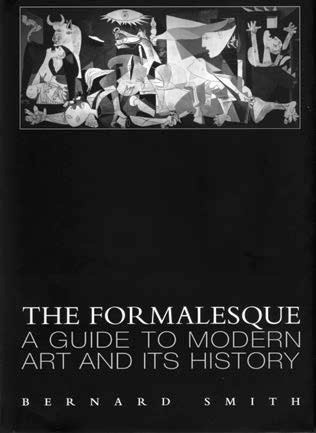
Is it a concept, a movement, a period, and how long will it last? No one seems to know because Modernism alters with our perceptions of our selves in relation to the past. Bernard Smith wants to end the phantasmagoria by calling out a name: the Formalesque. Can he succeed?
Smith, of course, is neither a magus nor an exorcist; he is the preeminent art historian in Australia. His works, voluminous, compelling, erudite, from Place, Taste and Tradition (1945) to Modernism's History (1998), have defined the shape of Antipodean art history for half a century now. More, they prefigure major themes in the intellectual discourse of the world: Smith's European Vision and the South Pacific (1960), for instance, anticipated Edward Said's Orientalism (1978) by nearly two decades.
But the significance of The Formalesque overreaches the eminence of its author. This slim work, superbly edited and illustrated, presents itself as 'an introductory primer to the art history of the 20th century.' From this modest intention springs an enormous question: what was the cultural phenomenon, bristling with innovations in every genre, which we still call Modernism?
Paradoxically, The Formalesque gains cogency by renouncing the more sweeping claims of Smith's earlier magisterial work Modernism's History. The term Formalesque, he now says in a candidly self-critical aside, applies only to the visual arts; let others decide how closely it describes the literature, philosophy, music, theatre of the same period. The period is roughly 1890 to 1970, the Formalesque its dominant style. Modernism, after all, cannot stretch forever into the future as a singular period, nor can Post-Modernism, for that matter, the elastic in 'post' has already snapped.
Of course, the word Modernism itself, as Smith reminds us, goes back to Suger (1081-1151), Vasari (1511-1574), and Shakespeare (1564-1616), in the sense of new, current, even common. That loose usage will persist because it does not refer to a specific theoretical model, a constellation of aesthetic features embedded in a particular historical moment. But we need another term, says Smith, the Formalesque, to designate the character of art in the twentieth century. Some will demur, particularly since names like Grotesque, Arabesque, Romanesque, Kafkaesque, tend to slip their moorings in a period and drift with the winds of fashion. And it is ironic that Smith himself resorts to the word 'Modern' in his subtitle. But for me, at least, nomenclature is secondary. The primary issue is empiric: how much of the art of the period between 1890 and 1970 can be reduced to varieties of formalism? Doesn't periodisation simplify too much?
Here Smith makes a persuasive case for the visual arts. Decorative designs; primitivism; the stripped-down architecture of Frank Lloyd Wright, Gropius, Le Corbusier; and, above all, abstraction in art fuse variously to create, beyond 'flatness', the immanent aesthetic of the Formalesque. Indeed, as Smith admits against his earlier penchant for figuration, 'nonfigural abstraction was the most innovative and permanent contribution that the Formalesque style made to Western art.'
Our cicerone is consistent. In the first chapter, On Words, he defines all his terms, from Abstraction to Zeitgeist. In the process, he distinguishes between troublesome and competing terms like Avant-Garde, Contemporary, Modern (the latter has 'completed its development and is now in the condition of 'something done''), and Post-Modern (just about done too, though the elliptical Po-Mo may have a fashionable afterlife). In the second chapter, On Style, Smith conducts a blitz history of art, from Lascaux to the present. But since he inclines to Carlyle's view that history 'is the essence of innumerable biographies', Smith reviews the shapers of art history, from Socrates, Plato, and Aristotle, through Vitruvius, Ghiberti, Vasari, Winckelman, Kant, Hegel, Burkhardt, Woelfflin and Warburg, to the critics most proximate to formalism, also discussed in the next chapter, Julius Meier-Graefe, Roger Fry, Clive Bell, Alfred Barr and Clement Greenberg.
The third chapter, On Form, contains the heart of the matter, the exemplars of the Formalesque in its international glory. Here are all the renowned artists and familiar movements, in France, Russia, Germany, England, America, Japan, Australia, New Zealand, Mexico, North Africa. Smith attempts to order this motley crowd of genius: 'The Formalesque style may be divided conveniently into three phases: an avant-garde phase (from c.1890 to c.1917); a high institutionalising and globalising phase (from c.1918 until c.1945); and a late phase (from c.1945 until c.1970). Of course these dates should not be taken precisely.' In all phases, however, Smith insists that artists and critics, like the founders of art history itself, never ignored their cultural milieu; formalism was never as narrow as ideological revisionists later claimed. And local traditions, for instance, Islamic nonfigural art, interacted with Western formalism in culturally interesting ways. But with the advent of Conceptual Art, reaction set in; the Formalesque declined.
That brings us to the final chapter On Meaning. Some may welcome the reaction as due politicisation of art and criticism; others may perceive it as a continual search for new meanings. Surrealism, we know, had already prefigured this quest, as did Dadaism, which Smith barely mentions, in its anarchic way. (The omission of Dada is odd in view of its reemergence in Post-Modernism.) More assertive in their opposition to formalism were prevailing tendencies in cultural studies: Marxism, feminism, anthropology, psychoanalysis and linguistics, in their various combinations and permutations.
Smith's epilogue is succinct and pre-ordained. What comes after the Formalesque? Just call it contemporary: we have neither the hindsight nor the foresight to call it anything else. Or quote Hegel, if you must: 'The owl of Minerva spreads its wings only with the falling of the dusk.' That does not signify art history has come to an end; it simply means that our present narrative is incomplete, waiting on future critics, curators, and collectors to do their work.
A primer, and more than a primer, The Formalesque has the lucidity of wide learning and deep reflection, and the critical goodwill to clarify the achievements of painters who have shaped our vision to this day (Cézanne, Van Gogh, Picasso, Kandinsky, Mondrian, Pollock, Duchamp&). But its rubric, the term Formalesque, will not explain that incommensurable moment, which we must still call 'modern', a moment that also includes Mahler and Stravinsky, Kafka and Beckett, Freud and Jung, Heidegger and Wittgenstein, Einstein and Heisenberg, Watson and Crick, not to mention the Somme, Stalingrad, Auschwitz, the Gulags, Hiroshima, the moon landings, television, digital technology&That moment is not yet done.












